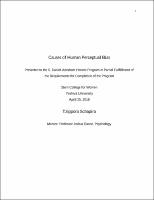Please use this identifier to cite or link to this item:
https://hdl.handle.net/20.500.12202/4507Full metadata record
| DC Field | Value | Language |
|---|---|---|
| dc.contributor.advisor | Bacon, Joshua | en_US |
| dc.contributor.author | Schapiro, Tzippora | - |
| dc.date.accessioned | 2019-07-10T17:08:16Z | - |
| dc.date.available | 2019-07-10T17:08:16Z | - |
| dc.date.issued | 2018-04-25 | - |
| dc.identifier.citation | Schapiro, Tzippora. Causes of Human Perceptual Bias. Presented to the S. Daniel Abraham Honors Program in Partial Fulfillment of the Requirements for Completion of the Program Stern College for Women Yeshiva University April 25, 2018. | en_US |
| dc.identifier.uri | https://hdl.handle.net/20.500.12202/4507 | - |
| dc.identifier.uri | https://ezproxy.yu.edu/login?url=https://repository.yu.edu/handle/20.500.12202/4507 | |
| dc.description | The file is restricted for YU community access only. | en_US |
| dc.description.abstract | The physical environment is dynamic and ever-changing, and human perception of the environment is as well. A phenomenon of human experience that constantly arises, and often creates conflict, is the phenomenon of perceptual bias. This fascinating and potentially dangerous aspect of the human condition is seen most clearly when the same stimulus elicits different perceptions in people. The cause of this bias is the method of organization used to perceive information, which differs between people, times, and situations. This paper presents several factors that contribute to methods of organization of information. The process of selective attention screens all incoming information and permits entry to only some of it. Expectations and predictions about the environment lead to the perception of stimuli that tend to fulfill those expectations. Motivations, stemming from many different sources, prescribe and dictate what will be perceived, sometimes even before the perceptual experience takes place. Finally, the environmental exposures that we have experienced throughout life in the cultures and environments we live in, form a basis that impacts the other cognitive activities of motivation, expectation, attention, and perception. The discussion presented in this paper does not fully explain the phenomenon of human bias, since the explanations are endless. However, it presents evidence that sheds light on some of the factors and mechanisms involved in biased perception. (from Conclusion) | en_US |
| dc.description.sponsorship | S. Daniel Abraham Honors Program of Stern College for Women | en_US |
| dc.language.iso | en_US | en_US |
| dc.publisher | Stern College for Women Yeshiva University. | en_US |
| dc.rights | Attribution-NonCommercial-NoDerivs 3.0 United States | * |
| dc.rights.uri | http://creativecommons.org/licenses/by-nc-nd/3.0/us/ | * |
| dc.subject | senior honors thesis | en_US |
| dc.subject | bias | en_US |
| dc.subject | human perception | en_US |
| dc.title | Causes of Human Perceptual Bias. | en_US |
| dc.type | Thesis | en_US |
| Appears in Collections: | S. Daniel Abraham Honors Student Theses | |
Files in This Item:
| File | Description | Size | Format | |
|---|---|---|---|---|
| Tzippora Schapiro Honors Thesis.pdf Restricted Access | The file is restricted for YU community access only. | 294.86 kB | Adobe PDF |  View/Open |
This item is licensed under a Creative Commons License

